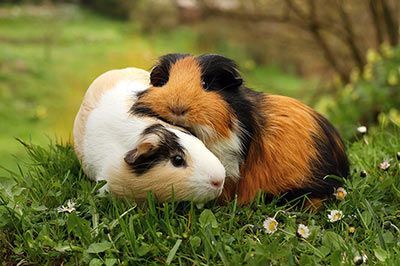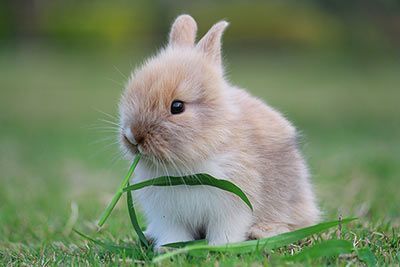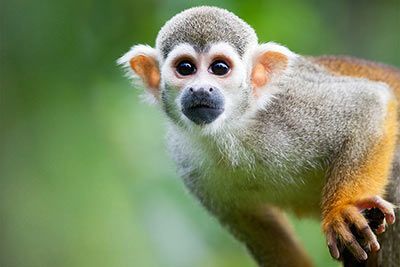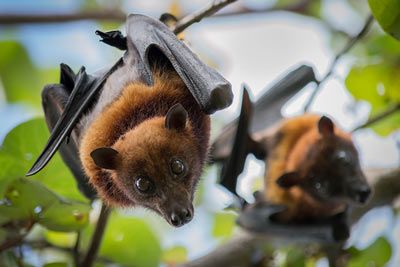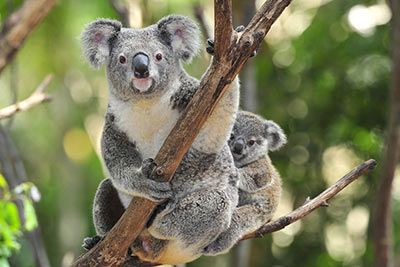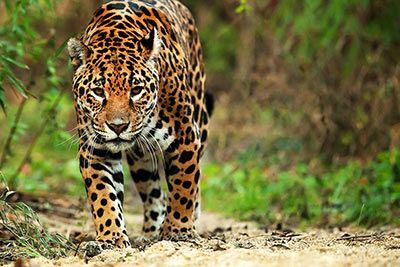Musk Ox
Musk Ox Facts
| Size | Up to 5 feet (150 cm) (shoulder height) |
| Speed | Up to 37 mph (60 km/h) |
| Weight | 440-880 pounds (200-400 kg) |
| Lifespan | 15-20 years |
| Food | Grass, leaves, moss, lichens |
| Predators | Wolves, bears, polar bears |
| Habitat | Canada, Greenland, Alaska, Siberia |
| Order | Even-toed ungulates |
| Family | Bovids |
| Scientific name | Large ungulate with longest fur of all mammals |
| Characteristics | Thick, shaggy coat |
Main Characteristics
Musk oxen are large and heavy ungluates that live in Canada, Greenland and Alaska. Of all mammals, they have the longest coat. It grows up to 24 inches (62 cm) long.
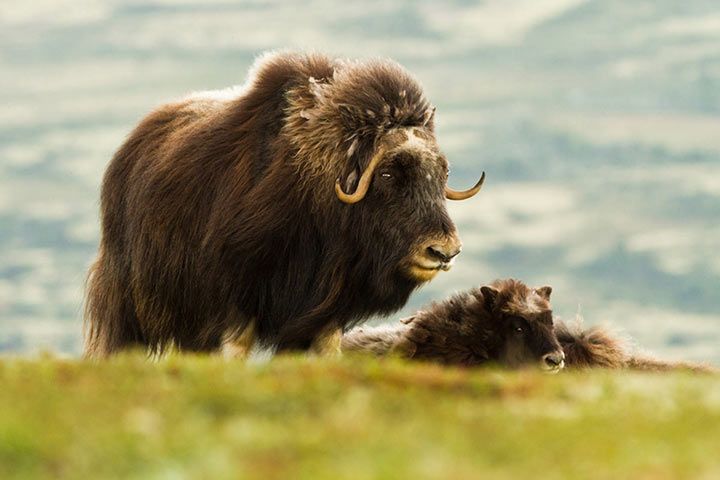
Species
Musk oxen look like buffalo or bison. However, they are not closely related to them. For a long time they were thought to be a mix of cattle and sheep. This led to the scientific name “ovibos”. It comes from Latin and means “sheep ox” (“ovi” = “sheep”, “bos” = “cattle”). In fact, the shaggy ungulate is closely related to goats and therefore belongs to the „caprinae“, which includes all goat species.
Name
Musk oxen were named for the smell of their urine. During the mating season it smells sweet, very similar to musk.
Distribution and Habitat
Most musk oxen live in Greenland, Canada, Siberia, Alaska. There are also small herds in Norway and Sweden. The animals prefer the treeless, barren tundra as a habitat. They are very well adapted to cold and dry landscapes.
Life Style
Musk oxen are diurnal. They form small herds of 8-20 animals, sometimes up to 100 animals in winter. They spend the summer in river valleys because there is lush grass there. In winter they move to higher areas to avoid snow and humidity. During the winter they sport two layers of fur: a long, protective top layer and a short, warming layer below. In spring they shed their undercoat.
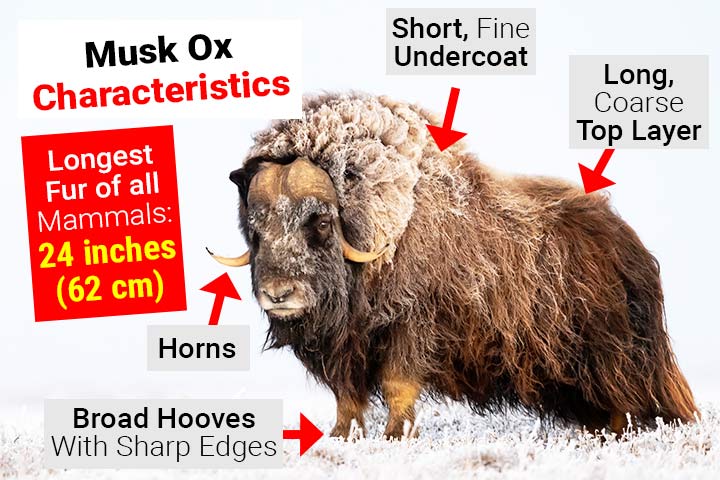
Anatomy and Appearance
Size and Weight
Musk oxen are very large and heavy. The bulls weigh 660-880 pounds (300-400 kg), have a shoulder height of 51-59 inches (130-150 cm) and a body length of 78-98 inches (200-250 cm). The cows are slightly smaller and lighter. They weigh 440-660 pounds (200-300 kg), reach a shoulder height of 43-51 inches (110-130 cm) and a body length of 53-78 inches (135-200 cm).
Horns
Musk oxen have curved horns with tips pointing upwards.
Hooves
The hooves of musk oxen are perfectly adapted to life on hard and frozen ground. They have sharp edges that help them break up layers of ice in winter. This is how they get to plants that grow underneath.
Coat
The musk oxen's coat is one of its most striking features. It's a double-coat and consists of two layers: a top coat and an under layer. It is so warm that they can survive down to -94 degrees Fahrenheit (-70 degrees Celsius) in winter. Nevertheless: Since they have no sebaceous glands, their hair is not waterproof. That's why they avoid wet areas in winter.
• Upper Coat
The musk ox has a long top coat. It protects it from snow, water and wind. The hair is very robust and coarse and grows up to 24 inches (62 cm long). They are called “awn hairs”. They're longest under the chin. No other mammal in the world has hair as long as the musk ox.
• Underfur
What keeps musk oxen nice and warm is their underfur, which is around 2 inches (5 cm long). It is eight times warmer than sheep's wool. And it's very, very soft - kind of like cashmere wool. The fact that you can still see anything of the animal is quite surprising, given its thick fur. Except for its hooves, horns, lips and nostrils, its body is completely covered with fine underfur. In the language of the indigenous peoples the underfur is called “Qiviuq”.
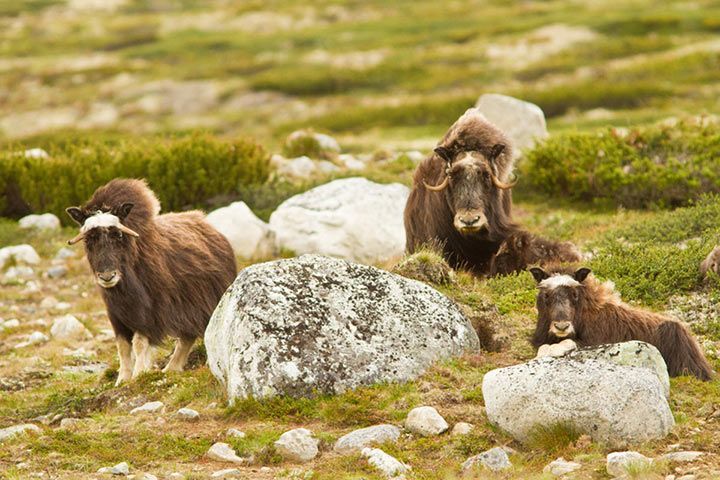
Diet
Musk oxen are herbivores. In summer they feed mainly on birch leaves, willow leaves, sedge grasses and sweet grasses. In winter they eat roots, lichens and mosses. They're ruminants. They chew their food, swallow it, regurgitate it, and chew it again. This makes their food easier to digest.
Behavior
Are Musk Oxen Dangerous?
Musk oxen are very strong and have pointed horns. If they feel threatened, they can become very dangerous. Fortunately, there are warning signals just before an attack. They lower their heads and rub their noses and eyes on their legs. They begin to snort and display their horns. That's when the fun is over. However, the animals usually don't attack people, but rather predators such as wolves or bears. And they only do it to defend themselves. Most of the time they are rather calm and peaceful. They only become aggressive during mating season. At that time, they engage in fierce fights with their male counterparts. The general recommendation is to maintain a minimum distance of 650 feet (200 meters), and with a dog, it should be 1,600 feet (500 meters).
Why Do Musk Oxen Need Horns?
Musk oxen use their sharp horns to protect themselves from predators and to compete for dominance within their herd.
Defense Behavior
When a predator approaches, the adults stand in a circle and face outward. No matter which side the attacker comes from, it will definitely be noticed. Inside the circle are the herd members that can't defend themselves well: calves, young animals, old, weak and sick animals. Sometimes a musk ox leaves the circle and boldly attacks. Its runs towards the predator with its head and tries to ram it and injure it with its horns.
Dominance Behavior
• Why Do Musk Oxen Charge Into Each Other?
Musk oxen fight against each other to establish their position in the herd. To do so, they engage in head-to-head collisions. They charge towards each other from a distance of 20 meters and ram their heads together with full force. To be more specific: their foreheads. They repeat this until one of them backs off. Sometimes they do it up to 20 times. Why don't they suffer from concussions? The explanation is quite simple - they have a thick horn bulge on their forehead that acts as a natural shock absorber, preventing any serious impact.
• The Horns Are Also Used in Dominance Fights
During the mating season in July and August, musk oxen can become quite aggressive. They fight for the highest possible rank within the herd – and they're not particularly delicate about it. They're even willing to risk injuring their fellow species. They thrust their sharp horns into their rival's sides. It is not uncommon for such a fight to end bloody.
Social Behavior
Musk oxen are very social animals. They maintain close bonds with each other. They do everything together. They eat at the same time and rest at the same time. They stand close to each other most of the time. Even if they have to run away from a predator, they run side by side.
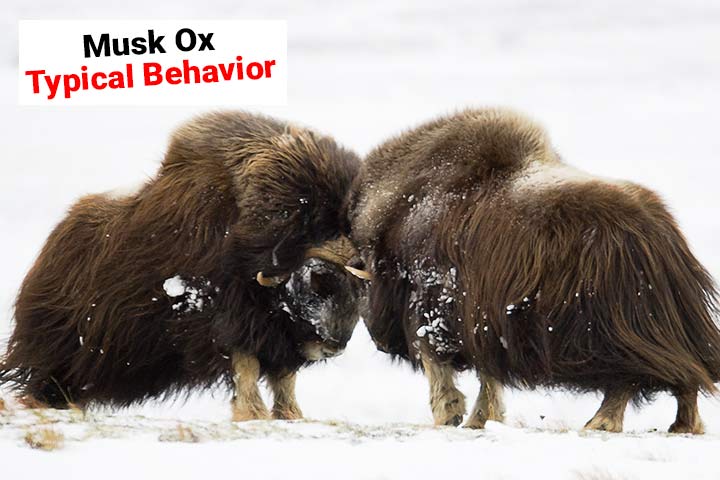
Senses and Abilities
Sense of Sight
The musk oxen's eyes are perfectly adapted to the lighting conditions in their habitat. They live so far north that it is very dark for several months of the year. That's why they have large pupils and a sensitive retina, allowing for excellent night vision. However, when there is snow, it is extremely bright. Then, the animals narrow their pupils to a horizontal slit so that only a little light enters them.
Adaption to the Cold
Musk oxen are warm-blooded animals. This means that they always have the same body temperature (more or less). And they have to maintain it. They get the required energy for this from the food they consume. However, during the winter months in the icy tundra, food supplies are rare. Luckily, the animals have a special trick. They can control their body temperature so that their legs are cooler than their body. They also have a special hemoglobin (= protein that transports oxygen). It is three times less sensitive to cold.
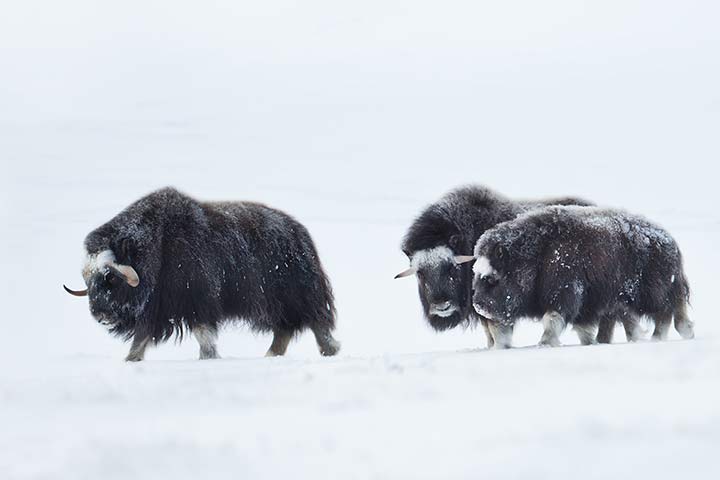
Enemies and Threats
Natural Enemies
Natural enemies are Arctic wolves and brown bears. Healthy, adult musk oxen are seldom preyed upon by predators. It is typically the young, old, or sick animals that are vulnerable to attacks.
• Musk Ox vs. Brown Bear - Who Will Win?
When a brown bear shows up, things get serious. Who will survive? Both animals have a similar size and weight. Both are very strong. While the brown bear has large paws with sharp claws. The musk ox has long, sharp horns. Nevertheless: In most cases the brown bear wins. But only if it fights a single animal. It has no chance against a herd.
• Musk Ox vs. Wolf – Who Will Win?
Wolves are very clever, but significantly smaller and lighter than a musk ox. If a wolf doesn't attack in a pack, it has no chance. A musk ox can seriously injure or even kill it with a powerful kick. Or it impales him with his horns and throws it through the air. Its bones break when it hits the ground.
Starvation, Cold and Drowning
The greatest danger to musk oxen is starvation. They eat as much as they can all summer long. But if they are unable to build up enough fat reserves before winter, they will starve before the first plants sprout next spring. The fewer fat reserves they have, the harder it is for them to deal with the cold. Some animals freeze to death because of this. Sometimes the animals drown when they walk over thin ice in spring and fall into a river.
Hunting
Musk oxen are hunted for their meat and for their fine undercoat. Fortunately, most countries have laws protecting the animals. At the moment, they aren't considered an endangered species.
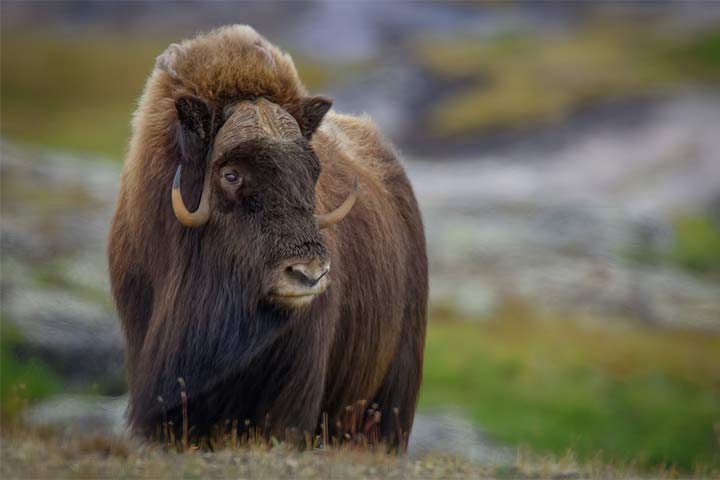
Importance for the Ecosystem
Musk oxen are very important for the balance of nature in the tundra. Plants are their main food source, and they help spread plant seeds to different locations by dispersing them in their droppings. This process allows new plants to thrive in the otherwise desolate tundra.
Reproduction
The mating season for musk oxen is between July and August. During this time, the bulls emit a special scent that smells like musk. The gestation period is 7-9 months. A baby weighs 22-30 pounds (10-14 kg) at birth. After 4-6 weeks the horns start to grow. It suckles for up to 10 months. After two years the calf is independent.
Fun Facts
Its Wool Keeps Other Animals Warm, Too
Musk oxen are permanently losing parts of their “underwear“ – particularly during the summer, when they shed their underfur. Little songbirds such as snow buntings or Lapland buntings collect the wool to pad out their nests.
The Musk Ox Is Related To:
- Mountain Goat
Animals in the Same Biome:
- Arctic Hare
- Arctic Fox
- Beaver
- Brown Bear
- Fox
- Lagopus
- Lapland Longspur
- Lemming
- Lynx
- Moose
- Polar Bear
- Raccoon
- Snow Bunting
- Snowy Owl
- Wolf
- Watch Now on animalfunfacts.net:
 All About Mammals
All About Mammals Animals in the Arctic
Animals in the Arctic














